Ever sat for practicing piano scales and thought, "Why, God, why?" If so, then let me tell you something. You aren't alone.
This was me every single day of my childhood (I began learning piano at 8 years of age). Anyway, I felt differently once my piano instructor provided this guide on how to learn piano scales.
Introduction to Piano Scales
1. Before practicing piano scales, ask yourself
what are piano scales?
Go ahead; you're ready to learn major piano scales if you can define them. However, if you fail to define what a scale is, first, let me tell you the definition.
Beginners and recreational pianists often keep killing themselves by practicing piano scales without knowing the definition. So, this is for every budding Chopin out there.
2. Definition of Piano Scales
What Are Scales?
Piano scales are a group of piano notes that have a specific distance between each other. Generally, piano scales range from one note to another note of the same type.
In addition, they're either piano instructor with a series of notes in between. These scales are always in alphabetical order with a root and a quality.
For instance, in the A major scale, "A" is the Root, and the quality of this scale is major. The Root is the note from where we begin to count our scale, and also, it's our first letter on this piano scale.
3. Why Should We Learn Piano Scales?
They are the fundamentals of piano playing. You maybe playing Baby Shark or ; if you don't know piano scales, you can't play it.
Scales are ABCs of western classical music. The world of piano learning is founded on the teachings of western classical music. No matter if it's jazz or pop. If you want to learn to play piano, you have no future without piano scales.
Practicing piano scales improves musical timing. I suggest every beginner practice scales, as it trains our internal metronomes. By doing so, you will be able to play a single piece at different speeds. On top of that, you will also never miss a beat while playing with other instruments.
Practicing scales is excellent ear training. Often we end up playing wrong notes without realizing it because our ears don't recognize them. However, you've to train your ears to become a professional pianist. And regularly practicing piano scales is a great way to do so.

Wondering how experts play piano by the ear? Get access to this beginner's guide and start learning today.
What are the Different Types of Piano Scales?
Undoubtedly, piano playing is complicated, but so is any other musical instrument. So, buckle up, and let's get ready to learn the different types of piano scales. According to western music theory, there are 12 different types of scale.
That's not it; as a beginner, you must learn to play each scale in 12 keys. I understand it's confusing for a newbie pianist. Well, don't worry! Let me break it down. As my piano instructor says, the major scales are an important part of learning piano scales.
Besides being the most common, they're very easy to learn first on piano. After major piano scales, one must learn minor piano scales. Next, we've the harmonic, natural, and melodic minors.
The other popularly learned piano scales are pentatonic, blues, and chromatic scales. Before going forward, first, let me tell you about WHOLE TONES & SEMITONES.
***Whole Tones & Semitones: Fundamental Units of Piano Scales Semitones/Half-Step in Piano Scales: It's the smallest interval not only for piano learning but also in theoretical western music. In the USA, it is commonly known as a half-step.
A semitone is a distance between any key and its immediate neighbor key. It's not necessarily between white-to-white keys or white-to-black. To make it easier, just think about a semitone as the immediate nearest note.
For example, A semitone from C is C# or B. Tones/ WholeTones/Whole-Step in Piano Scales: Two semitones make one whole tone/whole-step. Therefore, it's an interval of two semitones.
In other words, a whole tone is the distance of two half steps in either direction.

1. What are Major Piano Scales?
The major scale (also known as Ionian mode) is the easiest and commonest scale in western classical music.
It's a diatonic scale–consisting of intervals of five whole steps and two half steps.
The major scales go like this:
Root–Whole-Step–Whole-Step–Half-Step–Whole-Step–Whole-Step–Whole-Step–Half-Step
OR
Whole Tone–Whole Tone–Semitone–Whole Tone–Whole Tone-Whole Tone–Semitone
The easiest major scale to learn is definitely C major, as it doesn't have any sharps or flats.
C - D - E – F – G – A – B – C
Root - WT – WT - ST - WT – WT - WT- ST (Root)
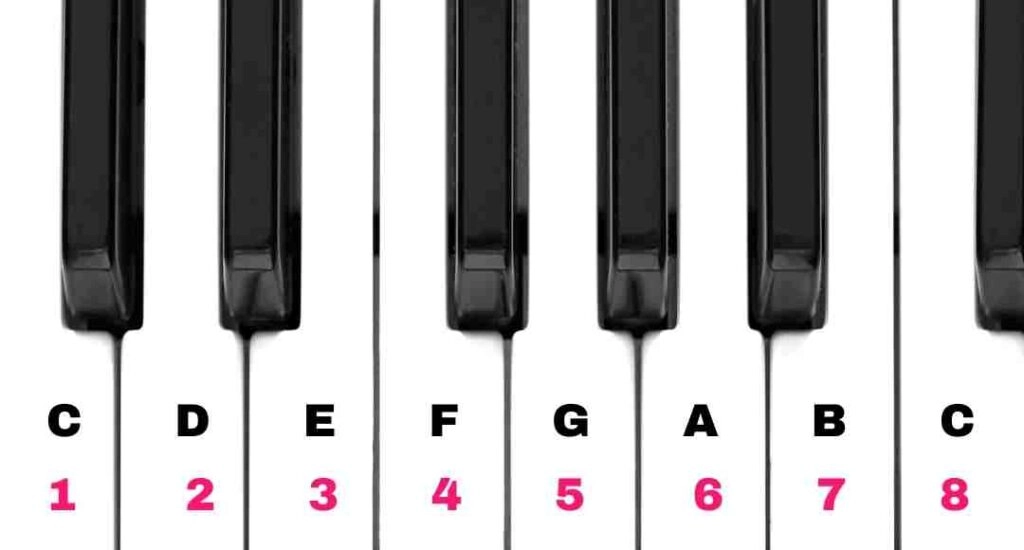
Here's a list of all major piano scales and notes.
C (C major) C – D – E – F – G – A – B – C
C# (C sharp) C# – D# – E# – F# – G# – A# – B# – C#
Db (D-flat) Db – Eb – F – Gb – Ab – Bb – C – Db
D (D major) D – E – F# – G – A – B – C# – D
Eb (E flat) Eb – F – G – Ab – Bb – C – D – Eb
E (E major) E – F# – G# – A – B – C# – D# – E
F (F major) F – G – A – Bb – C – D – E – F
F# (F sharp) F# – G# – A# – B – C# – D# – E# – F#
Gb (G flat) Gb – Ab – Bb – Cb – Db – Eb – F – Gb
G (G major) G – A – B – C – D – E – F# – G
Ab (A flat) Ab – Bb – C – Db – Eb – F – G – Ab
A (A major) A – B – C# – D – E – F# – G# – A
Bb (B flat) Bb – C – D – Eb – F – G – A – Bb
B (B major) B – C# – D# – E – F# – G# – A# – B Generally, major piano scales sound happy, hopeful, and full of energy. You can practice
Generally, major piano scales sound happy, hopeful, and full of energy. You can practice Do Re Mi to understand the piano major scale.
In Hindustani classical music, the major scale is popular as Bilaval, and in Carnatic music (South Indian music), this scale is known as Sankarabharanam.
2. What are Minor Piano Scales?
Piano Minor Scales are mainly of three different types:
Natural Minor Scale
Harmonic Minor Scale
Melodic Minor Scale
Natural Minor Scale
This minor piano scale is called natural because it's played according to its key signature. In other words, as a pianist, you don't need to change the notes at all.
The formula of the natural minor scale is:
Tonic–Tone–Semitone–Tone–Tone–Semitone–Tone–Tone OR
Root - WT - ST - WT - WT - ST - WT - WT (Root)
Let’s take a look at A natural minor scale:
A - B - C - D - E - F - G - A (Root)
Root - WT – ST - WT - WT – ST - WT- WT (Root)
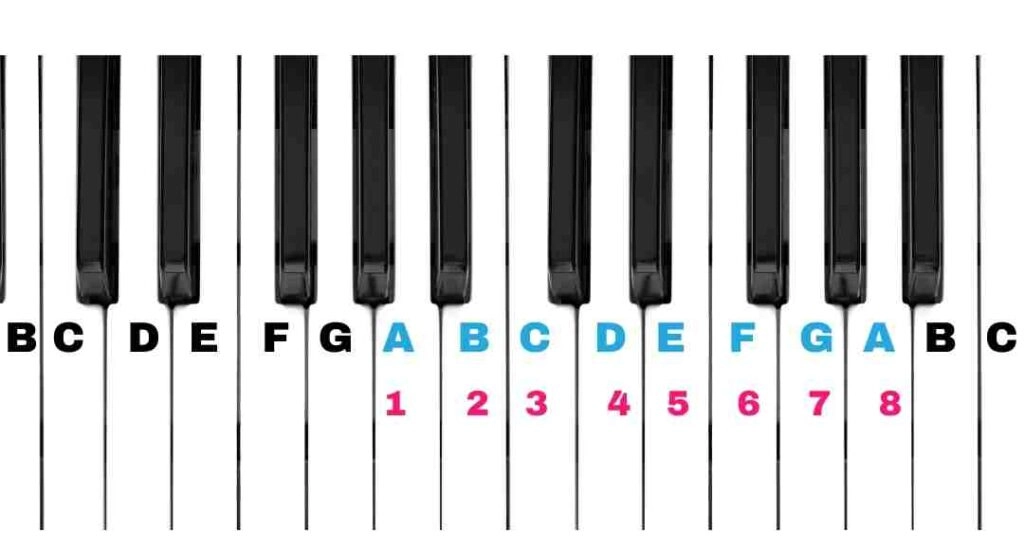
The natural minor scale is mostly used to play sad, heartbreaking, and alerting music.
Harmonic Minor Scale
The harmonic minor scale is the most commonly used minor scale by piano players.
Unlike the natural minor scale, the harmonic scale stands separately because of its raised 7th note.
***Raised notes are indicated with sharp symbols. It means while playing a certain note, instead of playing that note itself, we play the note above it. Also, it doesn't appear in the key signature. It is also called accidental notes.***
The 7th raised note means there's an interval of 3 semitones between the 6th and 7th notes.
The pattern of the harmonic minor scale is:
Tonic–Tone–Semitone-Tone–Tone–Semitone–3 semitones–Semitone
OR
Root - WT - ST - WT - WT - ST - 3ST - ST (Root)
Let's take a look at A Harmonic Minor Scale.
A - B - C - D - E - F - G# - A (Root)
Root - WT - ST - WT - WT - ST - 3ST - ST (Root)
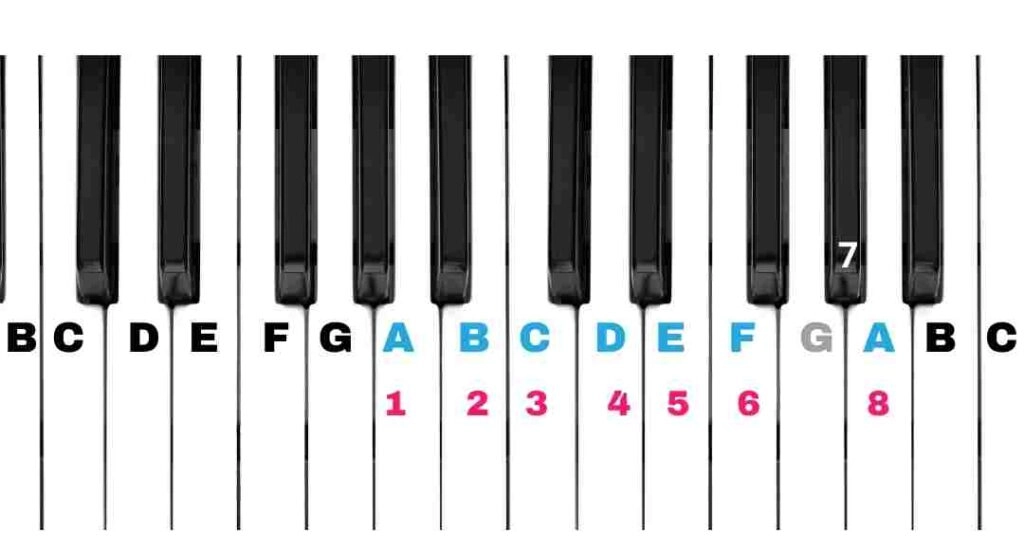
3. Melodic Minor Scale
While playing the melodic minor scale on the piano, it sounds like you're playing the major scale and minor scale at the same time.
Unlike the other two types of the minor scale, the melodic minor scale is comparatively difficult for beginners.
Flatten the third note of the scale to play a melodic minor scale. Then try to raise the 6th and 7th notes by a half-step while going up.
The pattern of melodic minor piano scales is slightly more complex than the previous ones. It is:
While playing ascending: Tonic–Tone–Semitone–Tone–Tone–Tone–Tone–Semitone
While playing descending: Tonic–Tone–Tone–Semitone–Tone–Tone–Semitone–Tone
OR
While playing ascending: Root - WT - ST - WT - WT - WT - WT - ST (Root)
While playing descending: (Root) - WT - WT - ST - WT - WT - ST - WT (Root)
Let's take a look at A Melodic Minor Scale (ascending).
A – B – C – D – E – F# – G# – A
Root - WT - ST - WT - WT - WT - WT - ST (Root)
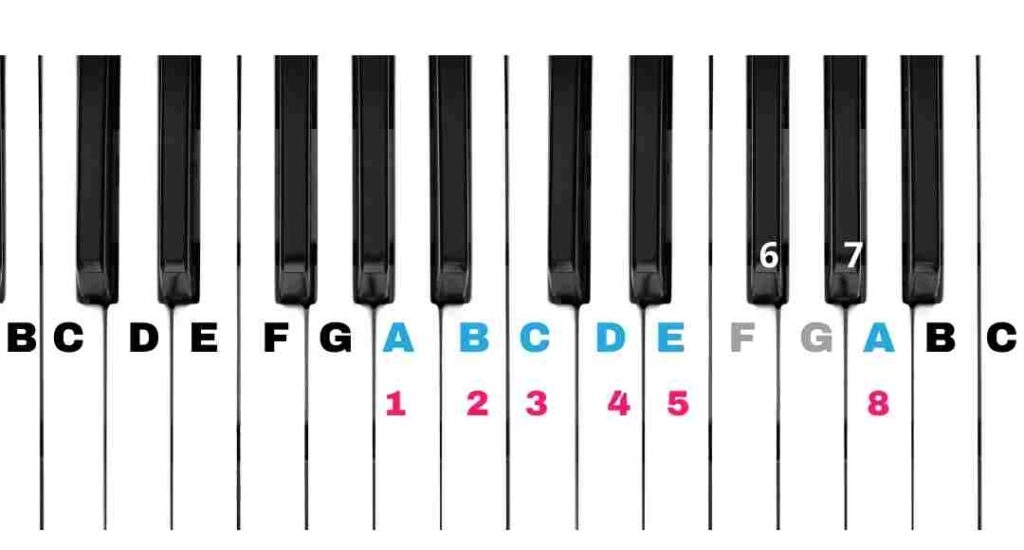
Now that we know what piano scales are, I hope you don't mistake it with chords. Because many beginners do.
What is the Difference Between Piano Scales and Piano Chords ?
Piano learners who confuse between piano scales and piano chords, I have got your back! Here's a brief explanation on piano scales vs piano chords.
Piano Chords | Piano Scales |
Piano chords are a definite set of three or more notes. | Piano scales are a group of 7 notes with the root (note) repeating at the octave. |
You can't play piano chords in different ways. | You can play a scale in any rhythm or order. |
You have to play all the keys at the same time to play a piano chord. | You can't play all the keys at the same time to play piano scales. |
In a piano chord, the root note is played only once. | In a piano scale, the root note is played both in the beginning and in the end. |
In total, there are 9 types of piano chords. | In the case of piano scales, there are 12 types. |
Example: A Major Chord. A – C# – E | Example: A Major Piano Scale. A – B – C# – D – E – F# – G# – A |
Curious about Piano Chords? Want to learn more? Checkout Piano Chords 101: A Simple Guide to Help You Get Started to find out. |


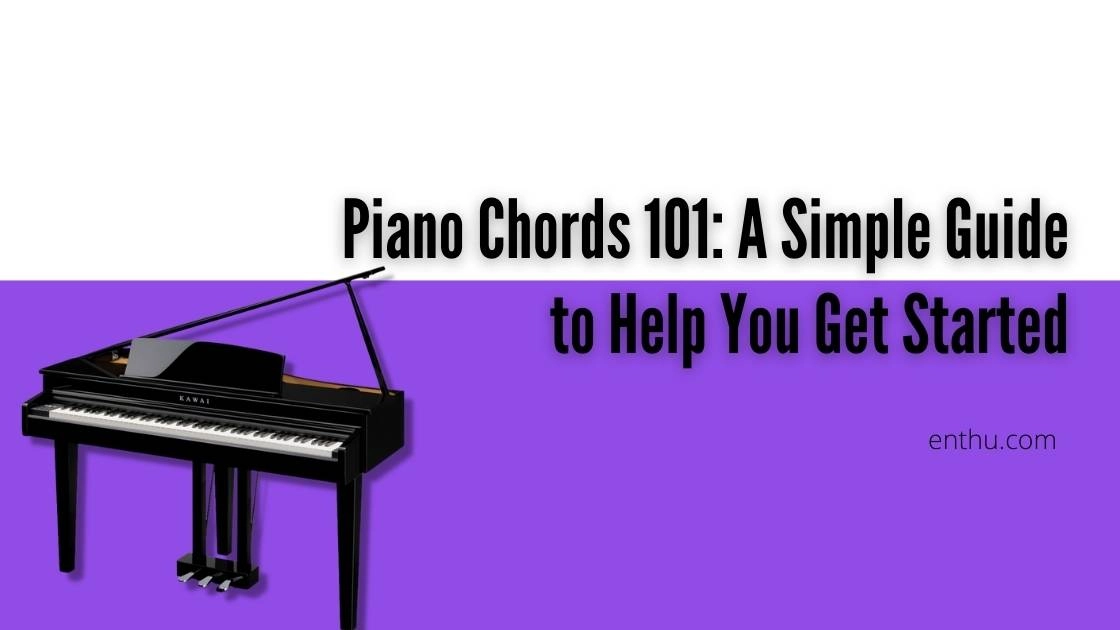
Conclusion
Learning piano scales is an overwhelming step for beginners. Even though it's mind-boggling, I recommend every learner take them seriously.
Dear aspiring Beethovens, I hope you begin with the major and minor piano scales as soon as possible. Believe in yourself and practice everyday.
FAQs
1) Which scale is best for me?
Even though every pianist must be thorough with all the scales, the major piano scale is the best for you. Especially if you're a beginner, you must practice the major piano scale and the minor piano scale. Once you are confident enough, you can begin with pentatonic, blues, and chromatic scales.
2) How do you memorize piano scales?
Here are some piano practice tips for the same. Try practicing the scales in sequential order. You should start with the tonic (Root) note, then work your way up the scale. Once you have completed the scale, practice the same scale in reverse order, starting with the lowest note and working your way up. For better memorizing results, you can try to use mnemonic devices. For example, the ABC song method. It stands for the first letter of each note in the scale. Finally, practice often! Take your piano lessons seriously.
3) What are accidental notes?
Accidental notes are written with sharp symbols. If a note is an accidental note, then, while playing that note, you should play the note above it. What I mean is you should play the above note instead of playing the note itself.


Comments